Menus
- BMW duel
- BMW R nineT Scrambler finds it lean more easily
- Spring elements have a common weakness
- Fleet curve dance on the country road
- A compromise between cultivated and rustic
- Scrambler delivers a little less power at the top
- Both brakes deliver excellent deceleration values
- The nineT braking system is difficult to measure
- Scrambler a little cheaper in comparison
- The test course
- MOTORCYCLE conclusion
- Technical data of the two BMW R nineT models
- BMW R nineT and R nineT Scrambler in price comparison
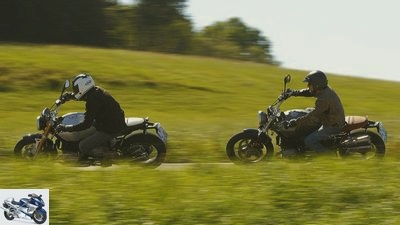
www.bilski-fotografie.de
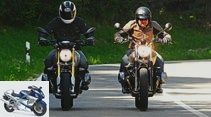

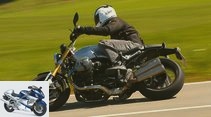

16 photos
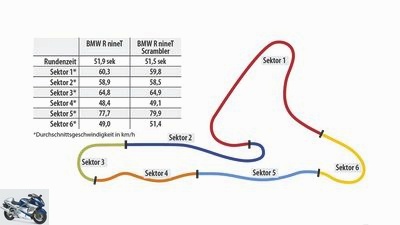
www.bilski-fotografie.de
1/16
In the course, the nineT sisters had to prove their chassis quality and steering precision.

www.bilski-fotografie.de
2/16
No, you don’t necessarily sit like that crouched on the Scrambler (right). Your driver allows himself a caricature of the nineT pilot here.
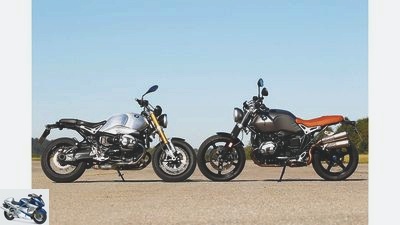
www.bilski-fotografie.de
3/16
The most conspicuous special equipment of the nineT (left) is the brushed aluminum tank with a visible weld seam on the top.

www.bilski-fotografie.de
4/16
Friction is also damping, which is probably why the fork ensures good front wheel grip. Suspension comfort? Well …
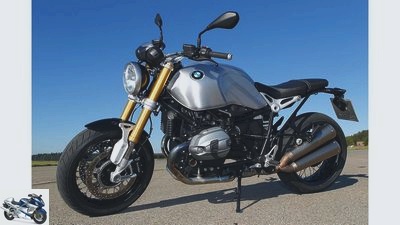
www.bilski-fotografie.de
5/16
In contrast to the Scrambler, the chrome-plated exhaust manifolds are standard.
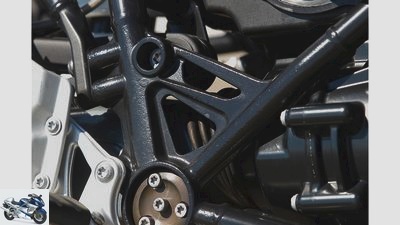
www.bilski-fotografie.de
6/16
On the right in the area of the swing arm mounting, the frame of the nineT consists of an investment cast part with two struts.
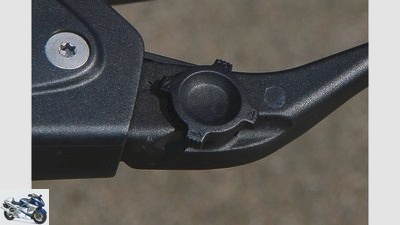
www.bilski-fotografie.de
7/16
The levers are adjustable in four ways.
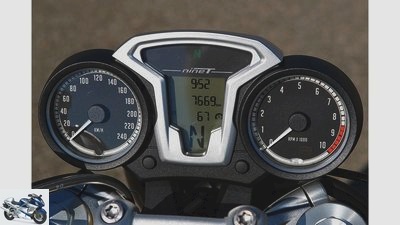
www.bilski-fotografie.de
8/16
The cockpit offers a wide range of displays.
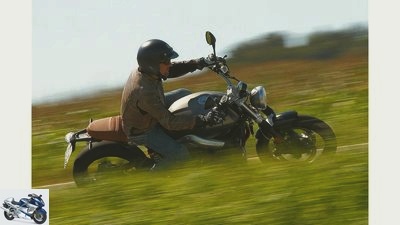
www.bilski-fotografie.de
9/16
A slight smile, light hands on the handlebars – if you swing through a sunny late summer day, you will experience the Scrambler at its best.
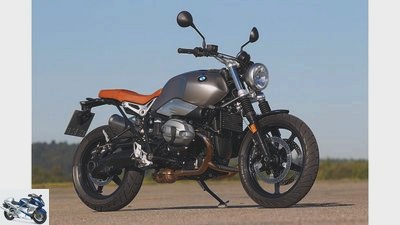
www.bilski-fotografie.de
10/16
The Scrambler differs from the nineT due to the larger front and narrower rear wheel as well as the conventional fork, the steel tank, the two-part, conventionally bolted brake calipers and the raised silencers.
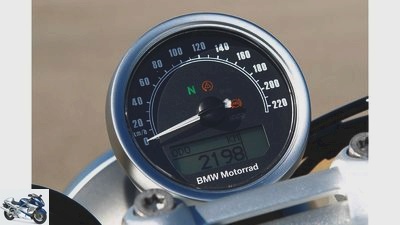
www.bilski-fotografie.de
11/16
The scrambler gets by with the minimal program of ads.
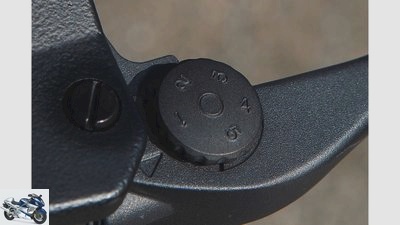
www.bilski-fotografie.de
12/16
Their levers are adjustable in five ways.
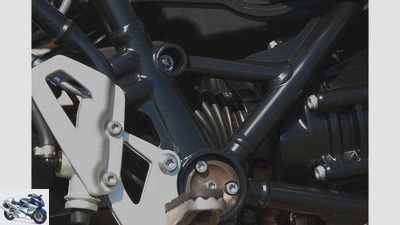
www.bilski-fotografie.de
13/16
The frame was changed on the right in the area of the swing arm mounting. This change has no functional effect, in contrast to the different wheel dimensions and the resulting changed chassis geometry.
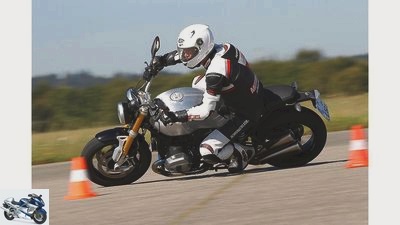
www.bilski-fotografie.de
14/16
BMW R nineT on the course.
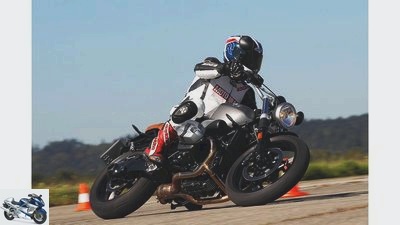
www.bilski-fotografie.de
15/16
BMW R nineT Scrambler on the course.
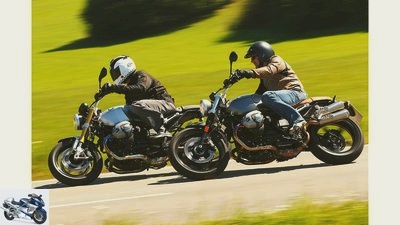
www.bilski-fotografie.de
16/16
The group test will be a head-to-head race?
BMW R nineT and BMW R nineT Scrambler in a comparison test
BMW duel
The 19-inch front wheel of the new BMW R nineT Scrambler is the most important difference to the original BMW R nineT. The resulting changes, especially in the steering feel, cannot be described in one sentence about the bike.
Three sets of clothes for a day of motorcycling – that seems a bit over the top, but is sometimes necessary. As in the comparison test of the BMW R. nineT and BMW R nineT Scrambler. The aim was to track down the chassis changes on a handling course that distinguish the new Scrambler from the original model: 19-inch front wheel, narrower 17-inch rear wheel, narrower tires, longer spring travel, softer rear spring, conventional fork, flatter steering head, longer caster.
Buy complete article
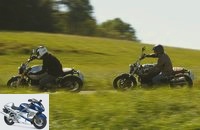
BMW R nineT and BMW R nineT Scrambler in a comparison test
BMW duel
Test machines are pushed to the limit
The 900 meter long course can be imagined like a supermoto race track, on which the test machines are pushed to the limit. That does not correspond to the character of the two retro BMWs, that is clear, but the laboratory test should give the testers driving impressions in a highly concentrated form. And because limit is the limit, they equipped themselves with one-piece leather suits and everything that goes with it in terms of racing equipment.
While the journey in clothing number one had brought the realization that both BMWs are running straight ahead at high speeds, even at their highest achievable speeds, waving in cloakroom number two gave the testers very different steering sensations. The BMW R nineT, with its relatively wide 17-inch wheels, initially offers a slightly greater resistance to the steering input than the BMW R nineT Scrambler. However, it then remains neutral over the entire usable slope range. It can also be precisely controlled when changing lean angles quickly. And it gives the feeling of better road holding.
BMW R nineT Scrambler finds it lean more easily
As already indicated, the Scrambler finds it lean more easily, it sweeps the first few degrees faster than the BMW R nineT, more light-footed. From a lean angle of around 25 degrees, however, the front wheel appears to be one to two hand’s widths outside the targeted line. Then the driver involuntarily turns the handlebars harder because he wants to pull into a tighter curve, and at the beginning he does it a little too hard. Obviously, the long caster creates a stronger steering torque than with the nineT, so you have to be more careful on the handlebars of the BMW R nineT Scrambler. Especially with spirited changes in lean angle, where you quickly pull the steering angle, which led to occasional front wheel slips on the course.
This tendency, which was clearly evident when driving in an extreme manner, can only be observed in a moderated form, even when driving quickly on winding country roads. Nevertheless, it can be said that the BMW R nineT Scrambler requires a softer driving style than the BMW R nineT. Although it turns in more quickly, it would be wise to take a little more time when navigating the desired curve path. Especially in bad grip conditions.
Spring elements have a common weakness
The differences in steering behavior hardly affect the lap and sector times in the course. In the passages that are taken from the slow and fast slalom of the top test course, the BMW R nineT Scrambler achieves slight advantages. Since the fast slalom is one of the fastest sections of the staked route in terms of absolute speed, there is probably a small advantage of 0.36 seconds in lap time. The BMW R nineT, on the other hand, has a slight advantage in wide corners, where absolute cornering speed and accuracy are essential. But in one and the other case it’s all about nuances.
The ride on the course made it clearer that the suspension elements of the two BMW R nineT sisters have a common weakness despite the different coordination: They do not respond sensitively and therefore only offer moderate suspension comfort. In particular, the riders find the hindquarters of both motorcycles to be quite lumpy, and the thinly padded seats do the rest to reinforce this impression. As the measurement of the negative suspension travel with and without the driver has shown, this is not due to the spring stiffness; both are in the normal range. There are also no abnormalities such as over-tightening of the damping that could cause it to get stuck in a deeply compressed position. The rebellious response must have something to do with the dynamic coordination of the damping and the quality of the spring elements.
Fleet curve dance on the country road
The upside-down fork of the nineT runs with significantly greater friction than the conventional fork of the Scrambler. Nevertheless, the BMW R nineT instills more confidence in the front wheel when driving quickly over bumps. This not only applies on the course, but also on the country road. When it comes to damping, the fork of the BMW R nineT Scrambler is quickly overwhelmed.
With the laps in the course and the subsequent brake measurements, the day and the testers got into heat, which is why the third set of motorcycle clothing was used in the early afternoon. Protective jeans and light jackets simply go better with the ease of being on the two BMW R nineTs. Photographer Jacek Bilski asked for a brisk curve dance on the country road, and by the way, the motorcycles provided plenty of other test impressions, this time in their traditional territory. For example this one: Anyone who has ever made fun of the gearbox of boxer BMWs is doing these two representatives of the genre an injustice.
A compromise between cultivated and rustic
In contrast to almost all other motorcycles, separated from the engine by a dry clutch, the first gear of the two BMW R nineTs can be engaged without a crack when stationary. The gear wheel pairings of the following gears also find each other easily, quietly and with short lever travel when driving. Only shifting down to first gear at a speed that is a little too high causes a slight mechanical click.
The air-cooled boxers also made a very good impression. Powerful and with an impressive sound in the middle and quite spirited at the top, they drove around 230 kilograms of motorcycle plus driver over the hills and through the valleys of the Swabian Alb. There are speed ranges in which they run noticeably rough, but overall they find the right compromise between cultivated and rustic that fits the concept of the motorcycles.
Scrambler delivers a little less power at the top
Compared to the current consumption values of the water boxer in the R 1200 RS (4.5 liters / 100 km), the two air-cooled boxers are a little more enjoyable to drink. They likely require more internal cooling through larger gasoline injections. This applies particularly to the BMW R nineT, which poured 5.1 liters of Super Plus per 100 kilometers into the combustion chamber on the cautiously driven lap of consumption. The BMW R nineT Scrambler made it with two tenths less.
The differences in consumption are likely to be due to the Euro 4 coordination of the BMW R nineT Scrambler. The test machine BMW R nineT is still model year 2016, i.e. homologated according to Euro 3. The 2017 model with Euro 4 homologation will have to come soon. This is probably why the Scrambler does not push as hard from the center and also delivers a little less power at the top. That had already been noticed on the course and was confirmed when accelerating with relish from the photo curves as well as later on the test bench.
Both brakes deliver excellent deceleration values
Whatever the exhaust of the BMW R nineT Scrambler has to do with the loss of performance, it has not become quieter. It shoots out of its silencers just as forcefully as the BMW R nineT. When the engines are started, passers-by spontaneously look for the sound source. The sound doesn’t seem uncomfortable; one or the other even showed an appreciative thumbs up. Which clearly proves: The message of the two R nineTs is getting through. Appearance and sound credibly signal a pleasurable departure from striving for perfection. Constantly increased driving dynamics, more and more comfort and touring suitability are not their thing. The nineT sisters stand for relaxed, yet brisk motorcycling. A very European form of “easy riding”, if you will. Which of course does not mean that a MOTORRAD tester will forgive all weaknesses of the two test motorcycles, especially not when it comes to braking.
First the good news: Both brakes, the one-piece, radially screwed calipers of the BMW R nineT, as well as the split, conventionally screwed calipers of the BMW R nineT Scrambler deliver excellent deceleration values. They can compress the motorcycles so that the driver can hear and see in the face of the inferno of deceleration that he himself has caused.
The nineT braking system is difficult to measure
But this bite also creates the biggest problem with the higher-quality nineT brake system – its effect is difficult to dose, the transition between nothing and everything can hardly be found. This is also due to too long a free travel on the handbrake lever. Even when it was spread as far from the handlebars as the adjustment allows, you held it at the pressure point with your whole, almost closed hand. Gentle application of the pads or sensitive metering of the braking force in an inclined position is almost impossible with this hand position.
Given the tough pressure point, it was clear that it couldn’t be air in the hydraulics. To shift the pressure point further forward, the testers dismantled the brake calipers and pads, then pushed the brake pistons back into their guides. Pistons often “stick” in their seals if they are only moved a few tenths of a millimeter until the linings are in contact. After the braking process, they are pulled back by the seals, so that a gap is created between the brake disc and the lining, which causes the free travel. Only when adhesive brake pistons are moved several millimeters in their guides do they “break” loose again and press the pads against the disc as far as possible.
Scrambler a little cheaper in comparison
On the BMW R nineT, too, the free travel on the lever after the operation was shorter than before, but it was still considerable. And with every hundredth of a millimeter of lining wear, it gets longer again. The simpler brake of the cheaper BMW R nineT Scrambler was better in terms of controllability, and the lever is also more convenient to hand. At this point and in other areas, the simple equipment of the scrambler does not have any functional disadvantages. The damping capacity of the conventional scrambler fork is purely a matter of coordination, the lack of hydraulic preload of the shock absorber is just a minor inconvenience that is of no consequence on a motorcycle that is mostly ridden solo.
And the small display instrument above the speedometer even looks cooler than the nineT’s cockpit. You can’t help but want a BMW R nineT Scrambler with a 17-inch front wheel that also costs 1900 euros less than the BMW R nineT. Maybe it will come in the form of the nineT Pure. However, these considerations faded into the background when Jacek Bilski was satisfied with the number of photos in the late afternoon and drove away with a car full of photo and measuring equipment as well as a rich collection of pylons. After work was thundered, the nineTs roared over the Swabian Alb in the most beautiful sunshine. It was a wonderful trip home.
The test course
www.bilski-fotografie.de
In the course, the nineT sisters had to prove their chassis quality and steering precision.
If you have enough space and pylons available, you can mark out a small racetrack. And experience how two very similar motorcycles show very different steering characteristics.
Admittedly, the route is not entirely fair to the BMW R nineT. It could not bring its advantages in fast corners to bear on the exactly 900 meter long course, while the BMW R nineT Scrambler was able to convert its light-footedness in the tight hooks and, above all, in the fast changes in lean angle into a narrow but reproducible lead.
In the very tight right-hand hook, which had to be driven at low revs in first gear, both BMW engines showed that they are capable of very smooth load changes and that they pull strongly even from low revs. Here the advantages lay on the side of the BMW R nineT, whose torque curve is higher than that of the BMW R nineT Scrambler over the entire usable speed range. This is not only measurable, it can also be clearly felt.
MOTORCYCLE conclusion
Despite the stubborn fork and poorly controllable brakes, the testers liked the nineT a little better than the BMW R nineT Scrambler. The decisive factors are the homogeneous steering and the smooth road holding of the BMW R nineT. Despite its somewhat ticklish steering behavior, the Scrambler is an extremely attractive motorcycle, also because of the lower price of 1900 euros. This was made possible thanks to the reduced equipment, which fortunately does not have any functional disadvantages.
Technical data of the two BMW R nineT models
BMW R nineT and R nineT Scrambler in price comparison
1000PS marketplace app
The R nineT family is very popular on the used market.
The BMW R nineT family is a complete success, which is also reflected in the used market. Both the RnineT and the R nineT Scrambler are available in large numbers and keep their price very well. In addition to many standard models, there are also some converted R nineTs. Here is an overview of all used BMW R nineT in Germany: used BMW R nineT and R nineT Scrambler in Germany.
Related articles
-
Comparison test KTM Duke against MuZ Mastiff
Comparison test between KTM Duke and MuZ Mastiff Must be fun Who says that a serious comparison test shouldn’t also be murderous fun. KTM …
-
Superbike comparison test: Ducati 996 SPS against Yamaha YZF-R7
Superbike comparison test: Ducati 996 SPS against Yamaha YZF-R7 Numerus Sausus These machines are not for everyone. If you really want to challenge one…
-
Husqvarna 701 SM and KTM 690 SMC R in comparison test
bilski-fotografie.de 14th photos www.bilski-fotografie.de 1/14 In contrast to the Husqvarna, the KTM cockpit is valuable and is highly suitable for…
-
Comparison test Honda Fireblade, VTR 1000 SP-2
Artistic comparison test Honda Fireblade, VTR 1000 SP-2 Everything stays different Honda is the only motorcycle manufacturer to produce two 1000cc super sports …
-
Test Voxan Scrambler Fashion creation Scrambler models from the seventies inspired the designers of the French brand Voxan. They created high two-wheel…
-
Comparison test of the Suzuki family
Gargolov comparison test of the Suzuki family Family affairs A shop window, four tempting sisters and around 7,000 euros in your pocket. A story in four …
-
Yamaha MT-09 and MV Agusta Brutale 800 in comparison test
bilski-fotografie.de 16 pictures bilski-fotografie.de 1/16 MV Agusta Brutale 800 and Yamaha MT-09. www.bilski-fotografie.de 2/16 Typical MV: Hybrid frame …
-
Comparison test of mid-range bikes
Gargolov comparison test mid-range bikes Underdogs They show off neither displacement nor performance, they do without a racing outfit and …
-
BMW R nineT Scrambler Ducati Scrambler 1100 test 2018
Jacek Bilski 11 photos Jacek Bilski 1/11 According to Schiller: should it come through this hollow axis? Hardly, but the BMW final drive allows beautiful…
-
Driving report Wunderlich R nineT Scrambler Six Days
20th photos 1/20 Driving report Wunderlich R nineT Scrambler Six Days. 2/20 Driving…